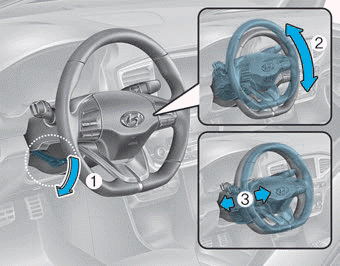Hyundai Ioniq: Air bag - Advanced supplemental restraint system / Why Didn't My Air Bag Go Off in a Collision?
Air bags are not designed to inflate in every collision. There are certain types of accidents in which the air bag would not be expected to provide additional protection. These include rear impacts, second or third collisions in multiple impact accidents, as well as low speed impacts. Damage to the vehicle indicates a collision energy absorption, and is not an indicator of whether or not an air bag should have inflated.
Air bag collision sensors
WARNING
To reduce the risk of an air bag deploying unexpectedly and causing serious injury or death:
- Do not hit or allow any objects to impact the locations where air bags or sensors are installed.
- Do not perform maintenance on or around the air bag sensors. If the location or angle of the sensors is altered, the air bags may deploy when they should not or may not deploy when they should.
- Do not install bumper guards or replace the bumper with a non-genuine HYUNDAI parts. This may adversely affect the collision and air bag deployment performance.
- Place the Engine Start/Stop button in the OFF or ACC position when the vehicle is being towed to prevent inadvertent air bag deployment.
- Have all air bag repairs conducted by an authorized HYUNDAI dealer.

1. SRS control module/Rollover sensor
2. Front impact sensor
3. Side pressure sensor
4. Side impact sensor


 Occupant Classification System (OCS)
Occupant Classification System (OCS)
Your vehicle is equipped with an Occupant Classification System (OCS) in the
front passenger's seat.
Main components of the Occupant Classification System
A detection device located within the front passenger seat cushion...
 Air bag inflation conditions
Air bag inflation conditions
Front air bags
Front air bags and the driver's knee air bag are designed to inflate in a frontal
collision depending on the severity of impact of the front collision...
Other information:
Hyundai Ioniq (AE) 2017-2025 Service Manual: Audio Unit. Components and components location
Components[RADIO/CD/MP3]Connector Pin Information No Connector A Connector B 1Rear speaker (LH +)-2Rear speaker (LH -)Mic (+)3--4--5-Antenna power6Camera powerIllumination (+)7Camera vidio inputMM CAN (+)8--9--10-Battery (+)11DTCBattery (+)12Steering key signalGround13Front speaker (LH +)Ground14Front speaker (LH -)-15Front speaker (RH -)Mic (-)16Front speaker (RH +)-17--18- -19-Illumination (-)20Camera power groundMM CAN (-)21Camera video ground-22-ACC23--24--25--26Steering key ground-27Rear speaker (RH -)-28Rear speaker (RH +)-29--30--31-IGN 332Camera(NC...
Hyundai Ioniq (AE) 2017-2025 Service Manual: Rear Pillar Trim. Components and components location
C..
Categories
- Manuals Home
- 1st Generation Ioniq Owners Manual
- 1st Generation Ioniq Service Manual
- Hybrid battery SOC (State of Charge) gauge
- How to Disconnect Normal Charger
- Temperature control
- New on site
- Most important about car
Tilt Steering / Telescope Steering
Adjust the steering wheel so it points toward your chest, not toward your face. Make sure you can see the instrument cluster warning lights and gauges. After adjusting, push the steering wheel both up and down to be certain it is locked in position. Always adjust the position of the steering wheel before driving.
WARNING
NEVER adjust the steering wheel while driving. This may cause loss of vehicle control resulting in an accident.

